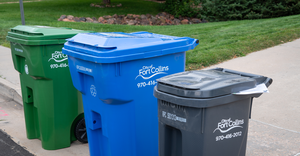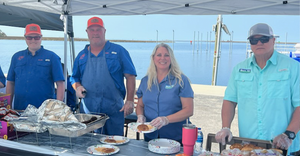Glass Half Full's Trautmann Eyes Enhanced Glass Recycling Initiatives in the Southeast
As she sits in her 40,000-square foot warehouse today, Trautmann, a 40 Under 40 Award recipient, tells why in those early college days she didn’t listen to people who told her recycling glass “wasn’t worth it.”

Franziska Trautmann and her business partner started collecting and crushing glass in the backyard of a fraternity house, and in a few short years, had diverted 7 million pounds of glass from landfills.
As she sits in her 40,000-square foot warehouse today, Trautmann, a 40 Under 40 Award recipient, tells why in those early college days she didn’t listen to people who told her recycling glass “wasn’t worth it.”
And she shares how, working with scientists and engineers across the Gulf South, she made something of the glass that enabled her to forge into unlikely markets –from coastal restoration to disaster relief.
Waste360: I see that you began collecting and hand-crushing glass in your backyard. Tell us more about how you got started. What inspired the company’s name?
Trautmann: Glass Half Full started, like most good ideas, over a bottle of wine. As seniors at Tulane University in New Orleans, my co-founder, Max and I finished our $2 bottle of wine and realized that like almost every other glass bottle in the state of Louisiana, it would end up in a landfill. We knew it would be nearly impossible to ship bottles to a processing plant, since there weren’t any nearby. So, we decided to come up with a way to use the glass locally.
When we found a machine that could turn the glass into sand, we jumped into action. We started a GoFundMe to raise money for this machine and a few other things we needed. We started collecting and crushing glass in the backyard of a fraternity house. We enlisted our friends to help us after classes and on weekends.
In the midst of our senior year and running around town collecting glass, we sometimes felt discouraged by people in the waste or sustainability space. Some people told us recycling glass wasn’t “worth it” while others told us that turning it into sand wasn’t actually helping. That was around the time we decided to call our company, Glass Half Full. Even though we might never be “perfect recyclers” or divert all of the glass from landfills, we could always look at the glass half full.
Waste360: How did you grow the company?
Trautmann: It definitely felt like Glass Half Full took off very quickly. It was clear that the New Orleans community wanted a way to recycle their glass. I honestly think that the pandemic sped things up for us. We started in February of 2020 and by mid-March the city was shut down. However, that meant that most people were staying home every night and enjoying a beverage in a glass bottle every now and then. I think that got people thinking more deeply about their waste and where it was going.
We quickly grew out of the backyard we started in and moved into a small workshop uptown. By September of 2020, we moved into the 40,000-square-foot facility that we’re in now. In the four years that we have been around, we have diverted more than 7 million pounds of glass from our landfills.
Waste360: Any “aha” moments along the way?
Trautmann: When we originally thought about recycling glass in New Orleans, we were thinking of how we could ship glass to someone else to process. Those roads all sort of lead to more expensive options that we couldn’t reasonably support. However, when we realized that we could turn glass back into sand, we had our first big aha moment. We knew sand was a locally needed resource, from sandbags for disaster relief to coastal restoration. This idea really jump started our plans and propelled Glass Half Full to be what it is today.
Waste360: What were you up against in making your model work? How did you do it?
Trautmann: The biggest unknown in our model was if and how the recycled glass sand could be used in coastal projects in Louisiana. There was very minimal research out there on the use of this material for coastal applications and most of it was done in Florida. I confided in some of my previous Tulane professors and we applied for a National Science Foundation grant through their Convergence Accelerator Program. We were awarded funding to create a team of scientists and engineers across the Gulf South to research the safety and feasibility of utilizing recycled glass sand in coastal restoration. The results were so positive that we have been able to use our sand in four coastal restoration projects, with more on the horizon.
Waste360: What were you doing before launching Glass Half Full?
Trautmann: Before starting Glass Half Full, I was a pretty regular college student. I studied chemical engineering with the hopes of contributing to scientific research around sustainability and waste. I was intrigued by the research into breaking down plastic for new materials created to replace it. I’m from a small town in Louisiana called Carencro. I grew up near a bayou, surrounded by nature and wildlife. I think that experience definitely shaped my love for the environment and my desire to contribute to solutions to climate change.
Waste360: What would you say to folks who say glass recycling doesn’t work?
Trautmann: I would say that’s a cop out… an excuse or similar attempt to dodge accountability. I think glass recycling definitely has its challenges. It’s a heavy material, which makes moving it very expensive and environmentally taxing. This results in glass recycling needing to be regionally focused. Not every region, including Louisiana, has the infrastructure for traditional glass recycling methods. For us, this meant we had to think outside the box. What else could we turn glass into [besides cullet for bottle manufacturing]? We decided that turning it into sand and using it locally made the most sense in our region, but that doesn’t mean that makes the most sense for the Midwest or New York or Seattle. It also doesn’t mean these methods will make the most sense in the long term. Recycling is ever changing, and we plan to keep up with the changes over time and adjust our strategy to make the biggest positive environmental impact we can.
Waste360: How did you get the word out about what you were doing?
Trautmann: We relied heavily on social media to get the word out. We joined TikTok in 2020 and started making videos about our story, journey, and our goals. To our surprise, they reached a lot of people! To this day, some of our collaborators, team members, and funders find us through TikTok. We had a lot of fun making videos and coming up with ideas. I now share a lot of my journey on my own account (@ecofran), and we share more about what Glass Half Full is doing on Instagram. Waste can sometimes be a forgotten industry, but I think if we find ways to make it fun and exciting, more people will want to get involved and contribute to making our industry better.
Waste360: What’s on the horizon for your business?
Trautmann: We have big plans at Glass Half Full. Short term, we are expanding regionally throughout Louisiana, Mississippi, and Alabama. We understand that the southeastern part of the U.S. is seriously lacking in glass recycling programs. We hope to be able to divert as much glass as possible from our landfills and convert it into something meaningful.
About the Author
You May Also Like




